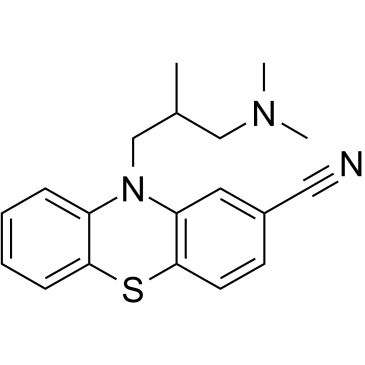Potential role of cortical 5-HT(2A) receptors in the anxiolytic action of cyamemazine in benzodiazepine withdrawal.
Amine Benyamina, Mickaël Naassila, Michel Bourin
Index: Psychiatry Res. 198(2) , 307-12, (2012)
Full Text: HTML
Abstract
The antipsychotic cyamemazine is a potent serotonin 5-HT(2A) receptor (5-HT(2AR)) antagonist. A positron emission tomography (PET) study in human patients showed that therapeutic doses of cyamemazine produced near saturation of 5-HT(2AR) occupancy in the frontal cortex, whereas dopamine D(2) occupancy remained below the level for motor side effects observed with typical antipsychotics. Recently, numerous studies have revealed the involvement of 5-HT(2AR) in the pathophysiology of anxiety and a double-blind, randomized clinical trial showed similar efficacy of cyamemazine and bromazepam in reducing the anxiety associated with benzodiazepine withdrawal. Therefore, we reviewed the above articles about 5-HT(2AR) and anxiety in order to understand better the anxiolytic mechanisms of cyamemazine in benzodiazepine withdrawal. The 5-HT(2AR) is the most abundant serotonin receptor subtype in the cortex. Non-pharmacological studies with antisense oligodeoxynucleotides and genetically modified mice clearly showed that cortical 5-HT(2AR) signaling positively modulates anxiety-like behavior. With a few exceptions, most other studies reviewed here further support this view. Therefore, the anxiolytic efficacy of cyamemazine in benzodiazepine withdrawal can be due to a 5-HT(2AR) antagonistic activity at the cortical level.Copyright © 2012 Elsevier Ltd. All rights reserved.
Related Compounds
| Structure | Name/CAS No. | Molecular Formula | Articles |
|---|---|---|---|
 |
Cyamemazine
CAS:3546-03-0 |
C19H21N3S |
|
Identification and quantification of 35 psychotropic drugs a...
2015-03-01 [Int. J. Legal Med. 129(2) , 259-68, (2015)] |
|
Fatal intoxication with milnacipran
2008-01-01 [J. Forensic Leg. Med. 15(6) , 388-90, (2008)] |
|
Prise en charge médicamenteuse de l’anxiété chez le patient ...
2011-01-01 [Encephale 37 Suppl 1 , S83-9, (2011)] |
|
Characterization of human cytochrome P450 enzymes involved i...
2007-12-01 [Eur. J. Pharm. Sci. 32(4-5) , 357-66, (2007)] |
|
[Acute Datura stramonium poisoning in an emergency departmen...
2007-10-01 [Presse Med. 36(10 Pt 1) , 1399-403, (2007)] |